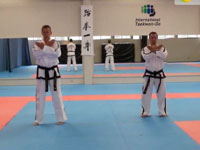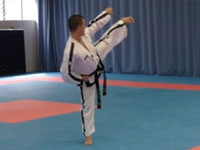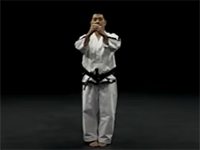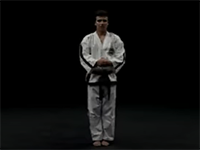
Patterns Library
Videos and Articles to help with your Patterns

Chon-Ji Video
Means literally the “Heaven the Earth.”It is, in the Orient, interpreted as the creation of the world or the beginning of human history, therefore, it is the initial pattern played

Chon-Ji Tul
Chon-Ji means literally the “Heaven the Earth.”It is, in the Orient, interpreted as the creation of the world or the beginning of human history, therefore, it is the initial pattern

Dan-Gun Video
Dan-Gun is named after the holy Dan-Gun, the legendary founder of Korea in the year of 2333 B.C. (21 Movements).

Do-San Video
Do-San is the pseudonym of the patriot Ahn Chang-Ho (1876-1938). The 24 movements represent his entire life which he devoted to furthering the education of Korea and its independence movement.

Won-Hyo Video
Won-Hyo was the noted monk who introduced Buddhism to the Silla Dynasty in the year of 686 A.D. (28 Movements).

Yul-Gok Video
Yul-Gok is the pseudonym of a great philosopher and scholar Yi I (1536-1584) nicknamed the “Confucius of Korea”. The 38 movements of this pattern refer to his birthplace on 38′ latitude

Joong-Gun Video
Joong-Gun is named after the patriot Ahn Joong-Gun who assassinated Hiro- Bumi Ito, the first Japanese governor-general of Korea, known as the man who played the leading part in the

Toi-Gye Video
Toi-Gye is the pen name of the noted scholar Yi Hwang (16th century), an authority on neo- Confucianism. The 37 movements of the pattern refer to his birthplace on 37 latitude, the

Hwa-Rang Video
Hwa-Rang is named after the Hwa-Rang youth group which originated in the Silla Dynasty in the early 7th century. The 29 movements refer to the 29th Infantry Division, where Taekwon-Do developed into

Choong-Moo Video
Choong-Moo was the name given to the great Admiral Yi Soon-Sin of the Lee Dynasty. He was reputed to have invented the first armoured battleship (Kobukson) in 1592, which is

Kwang-Gae Video
KWANG-GAE is named after the famous Kwang-Gae-Toh-Wang, the 19th King of the Koguryo Dynasty, who regained all the lost territories including the greater part of Manchuria. The diagram represents the

Po-Eun Video
PO-EUN is the pseudonym of a loyal subject Chong Mong-Chu (1400) who was a famous poet and whose poem “I would not serve a second master though I might be

Ge-Baek Video
GAE-BAEK is named after Gae-Baek, a great general in the Baek Je Dynasty (660 AD). The diagram represents his severe and strict military discipline (44 movements). Video kindly provided by

Eui-Am Video
EUI- AM is the pseudonym of Son Byong Hi, leader of the Korean independence movement on March 1, 1919. The 45 movements refer to his age when he changed the name

Choong-Jang Video
CHOONG-JANG is the pseudonym given to General Kim Duk Ryang who lived during the Lee Dynasty, 14th century. This pattern ends with a left-hand attack to symbolize the tragedy of

Juche Video
JUCHE is a philosophical idea that man is the master of everything and decides everything. In other words, the idea that man is the master of the world and his

Sam-Il Video
SAM-IL denotes the historical date of the independence movement of Korea which began throughout the country on March 1, 1919. The 33 movements in the pattern stand for the 33 patriots who

Yoo-Sin Video
YOO-SIN is named after General Kim Yoo Sin, a commanding general during the Silla Dynasty. The 68 movements refer to the last two figures of 668 A.D., the year Korea was united.

Choi-Yong Video
CHOI-YONG is named after General Choi Yong, premier and commander in chief of the armed forces during the 14th century Koryo Dynasty. Choi Yong was greatly respected for his loyalty,

Yon-Gae Video
YONG-GAE is named after a famous general during the Koguryo Dynasty, Yon Gae Somoon. The 49 movements refer to the last two figures of 649 A.D., the year he forced the Tang

Ul-Ji Video
UL- JI is named after general Ul-Ji Moon Dok who successfully defended Korea against a Tang’s invasion force of nearly one million soldiers led by Yang Je in 612 A.D.,

Moon-Moo Video
Moon-Moo honours the 30th King of the Silla Dynasty. His body was buried near Dae Wang Am (Great King’s Rock). According to his will, the body was placed in the

So-San Video
SO-SAN is the pseudonym of the great monk Choi Hyong Ung (1520-1604) during the Lee Dynasty. The 72 movements refer to his age when he organized a corps of monk soldiers with

Se-Jong Video
SE-JONG is named after the greatest Korean King, Se-Jong, who invented the Korean alphabet in 1443, and was also a noted meteorologist. The digram represents the king, while the 24 movements refer

Tong-Il Video
TONG-IL denotes the resolution of the unification of Korea which has been divided since 1945. The diagram symbolizes the homogenous race (56 movements). Video kindly provided by TKDCoaching.com
Have a suggestion?
Let us know your recommendation for a video or other resource we can use on this website



